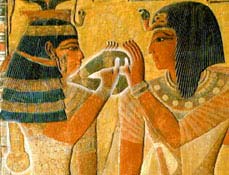
Menet Necklace
(menet, menat, menit)
Appearance: The menet necklace was a wide beaded collar with a heavy counterweight (or "counterpoise") in the back to help keep it in place. The type of necklace depicted in the hieroglyph does not appear to have been common until the New Kingdom.
The necklace, like the sistrum may have functioned as a percussion instrument in religious functions.
Meaning: Symbolically, the necklace was associated with the goddess Hathor, and her son Ihy. As an important attribute of "the Great Menet" (as Hathor was sometimes called), it may have functioned as a medium through which she transmitted her power. In many images of the goddess, she is shown offering the necklace to the king. The queen was often a high priestess of Hathor and thus is often shown herself offering the necklace. On the shrine of Tutankhamon, his wife Ankhesenamon was depicted offering the pharaoh a menet necklace constructed as a personification of Hathor. In images such as these, the menet appears to have been associated with such concepts of life, potency, fertility, birth and renewal.
In the Adventures of Sinuhe, the title character returns to Egypt after many years of living in the barbarous lands of Asia. Upon his reception in the court of the pharaoh, priestesses ritually offered him the menet and the sistrum so that he could be reborn into Egyptian culture and life.
When included as decoration or as an amulet in mortuary settings, the menet was associated again with Hathor, but in her duty as the goddess of the western necropolis and her part in the rebirth of the dead.
In many representations of Hathor as the divine cow she is shown wearing the menet necklace. In later periods, other goddesses in cow form (such as Nut or Isis) were shown wearing Hathor's menet.
Digg This!
![]() Del.icio.us
Del.icio.us
![]() Stumble Upon
Stumble Upon
